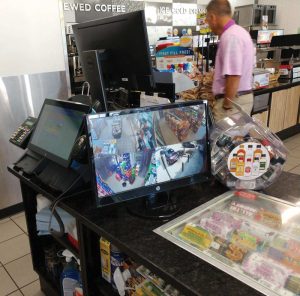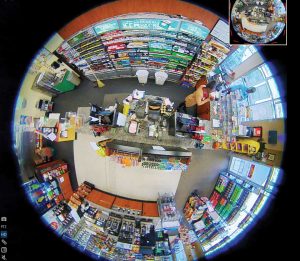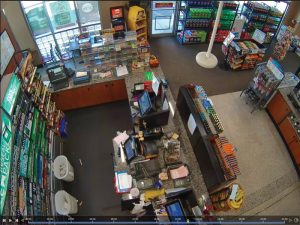— By Del Williams —
Taking convenience stores to the next level with IP network surveillance systems.
Convenience stores and mini marts have traditionally installed surveillance cameras to deter crime and encourage safety, but too often these have provided images that lacked detail, particularly in low light conditions. Retrieving video has usually been tedious, requiring endless searching and scanning to find the desired footage. Sharing and archiving of the video has also been cumbersome, wasting precious technical and management resources.

Del Williams, Contributing Writer
Now advanced digital IP video cameras and recorders are capturing clearer images inside and outside the store in various lighting conditions to deter theft, fraud and unjustified claims such as slip-and-fall incidents. By providing easily retrievable and emailable surveillance video evidence, this approach is even enabling the swift collection of full compensation when store property is damaged. The surprisingly economical IP network surveillance systems are also enabling executives to efficiently monitor store conditions from home, headquarters or anywhere with an Internet connection.
“With an advanced surveillance camera system, a convenience store chain could achieve ROI within a year through better prevention of theft, fraud and unjustified claims as well as improved operational oversight,” says Todd Harrison, IT director who oversees loss prevention camera surveillance for Sprint Food Stores, which operates 20 convenience stores in Georgia and South Carolina.
Previously, Sprint Food Stores used lower resolution cameras that required onsite DVD burning as a means of storage. According to Harrison, limitations in surveillance video quality and connectivity were the main reasons that the convenience store chain sought an alternative.
 As a solution, Harrison turned to an advanced surveillance camera system that includes various high-resolution digital cameras, network video recorders and related equipment. This provides comprehensive video coverage inside and outside of stores, the corporate office and remote offices — even in low-light/varying light conditions — and enables adjusting the angle or focus to capture the visual evidence required.
As a solution, Harrison turned to an advanced surveillance camera system that includes various high-resolution digital cameras, network video recorders and related equipment. This provides comprehensive video coverage inside and outside of stores, the corporate office and remote offices — even in low-light/varying light conditions — and enables adjusting the angle or focus to capture the visual evidence required.
“[The provider] worked with us on exact camera placement and suggested slight adjustments to improve visibility and get the maximum coverage with the minimum number of cameras,” says Harrison.
Deterring Theft
One benefit of implementing the new surveillance system was how it eliminated “blind spots” within stores, such as inside a walk-in beer cooler, which made it easy to prevent theft and catch thieves, says Harrison.
“We put a camera inside the walk-in beer cooler and at other blind spots so we can monitor them at the front counter,” he says. “This prevents theft so we don’t have to prosecute, and provides video evidence if we do.”
 Among the equipment installed in stores, Harrison appreciates a 3-megapixel fisheye network camera that provides a full, 360-degree view over a web browser. This provides three, simultaneous pan, tilt and zoom video streams that can be viewed live or recorded.
Among the equipment installed in stores, Harrison appreciates a 3-megapixel fisheye network camera that provides a full, 360-degree view over a web browser. This provides three, simultaneous pan, tilt and zoom video streams that can be viewed live or recorded.
“The great part about the 360-degree view camera is being able to view the whole store,” says Harrison. “You can zoom in for a close up of what you want to focus on, and quickly see which store camera has the best view.”
The surveillance system can also help to identify and deter potential cash register transaction theft, which can occur, for instance, through unscrupulous voids or no sale register transactions. The surveillance system integrates with the store POS system and provides Smart ER exception reports, a type of advanced filtering software included with the surveillance system. So quick analysis of thousands of register transactions can be done to identify suspicious activity and pull up video of it for review.
“The district manager may get alerts from the exception system if there are an extreme number of voids or no sales, so may bring up 10 seconds of video after each to review,” says Harrison.
Fraudulent Claims
Deterring and disproving fraudulent claims is another benefit of implementing easily accessible, high quality surveillance video. The information can be used to deter unwarranted claims for slip-and-fall or workers’ compensation, for example.
“When a store was involved with a slip and fall claim, we were able to show on video that other customers took the same path as the accuser without incident, and that less harm was involved than stated,” says Harrison. “We retrieved the video, sent it to her lawyer, and her lawyer dropped the case.”
 Occasionally, patrons demand chargebacks, claiming that they did not make the purchase. Previously, managers had little recourse. Now this can be resolved much more effectively.
Occasionally, patrons demand chargebacks, claiming that they did not make the purchase. Previously, managers had little recourse. Now this can be resolved much more effectively.
For instance, when a customer claimed that he could not possibly fit 20 gallons of gas in his Ford Escort, Harrison says the incident was resolved with a simple callback after reviewing some revealing video.
“We viewed him filling gas cans next to his car before putting them in,” says Harrison. “We asked, ‘Did you forget your two 5-gallon gas cans? We have you on video.’ That ended the dispute.”
Collecting Compensation
Surveillance video can even be used as evidence to collect costly damage to equipment or store property.
Harrison relates how at one location a truck driver ran into a 3-foot-high, LED diesel fuel sign, destroying it, before driving off.
“When we emailed the trucking company high-quality surveillance video of the incident with their truck/trailer number and company name clearly readable, we were promptly compensated,” says Harrison. “That alone paid for the store’s surveillance system.”
On another occasion, Sprint Food Stores had a storage building roof torn off by a truck just before dawn without the driver stopping to talk to anyone, according to Harrison.
“Because our infrared cameras provided clear identifying information on the truck, we were able to quickly file a claim with the truck company and recover 100% of damages,” says Harrison. “There was no delay in receiving payment because we had proof.”
Streamlining Operations
Compared with the chain’s previous approach, implementation of the advanced system has significantly improved management.
“Video can be reviewed and archived remotely as needed, which eliminates the need to spend hours every week traveling to burn DVDs for video storage,” says Harrison.
He notes that the remote viewing of store video also gives the chain’s operations manager a window into how each store is doing without having to travel to each on a daily basis. A quick glance, for instance, can help to verify that employees are in uniform, at their work stations, and serving customers without long lines, etc.
The surveillance system also has an optional video analytics software module that could help Sprint Food Stores more effectively merchandise retail items, according to Harrison, who notes that the chain is not currently using this option, but may do so in the future.
“The video analytics module would basically pinpoint where in the store people are traveling, where they stop, and where they spend time, over time,” says Harrison. “So you can tell which products interest people the most, and how to improve product placement and merchandising.”
When convenience store owners are ready to take theft/fraud prevention and operational efficiency to the next level with advanced video surveillance systems, they will often find that the most effective choice is to partner with a flexible vendor capable of installing a turnkey solution that integrates with their equipment to fully meet their needs.
— Del Williams is a Torrance, California-based technical writer, writing on behalf of ERC, a Kennesaw, Georgia-based supplier and integrator of surveillance and POS systems. ERC has provided more than 10,000 stores and restaurants with surveillance or POS systems, including Arby’s, Popeyes, KFC and Burger King. For more information, visit www.erconline.com.
